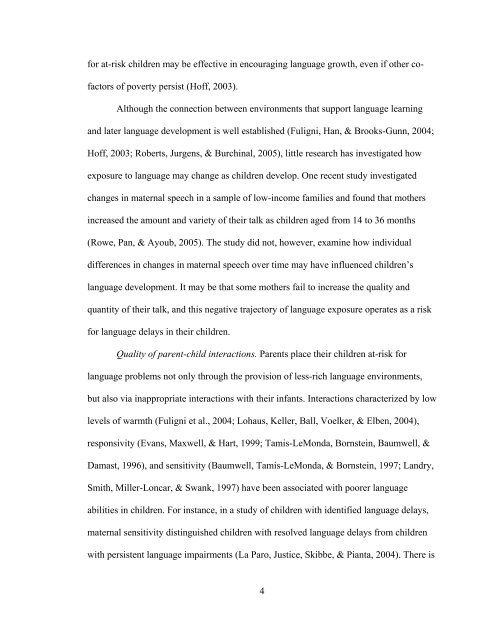DIFFERENCES BETWEEN ADOLESCENT AND ADULT MOTHERS ...
DIFFERENCES BETWEEN ADOLESCENT AND ADULT MOTHERS ...
DIFFERENCES BETWEEN ADOLESCENT AND ADULT MOTHERS ...
You also want an ePaper? Increase the reach of your titles
YUMPU automatically turns print PDFs into web optimized ePapers that Google loves.
for at-risk children may be effective in encouraging language growth, even if other cofactors<br />
of poverty persist (Hoff, 2003).<br />
Although the connection between environments that support language learning<br />
and later language development is well established (Fuligni, Han, & Brooks-Gunn, 2004;<br />
Hoff, 2003; Roberts, Jurgens, & Burchinal, 2005), little research has investigated how<br />
exposure to language may change as children develop. One recent study investigated<br />
changes in maternal speech in a sample of low-income families and found that mothers<br />
increased the amount and variety of their talk as children aged from 14 to 36 months<br />
(Rowe, Pan, & Ayoub, 2005). The study did not, however, examine how individual<br />
differences in changes in maternal speech over time may have influenced children’s<br />
language development. It may be that some mothers fail to increase the quality and<br />
quantity of their talk, and this negative trajectory of language exposure operates as a risk<br />
for language delays in their children.<br />
Quality of parent-child interactions. Parents place their children at-risk for<br />
language problems not only through the provision of less-rich language environments,<br />
but also via inappropriate interactions with their infants. Interactions characterized by low<br />
levels of warmth (Fuligni et al., 2004; Lohaus, Keller, Ball, Voelker, & Elben, 2004),<br />
responsivity (Evans, Maxwell, & Hart, 1999; Tamis-LeMonda, Bornstein, Baumwell, &<br />
Damast, 1996), and sensitivity (Baumwell, Tamis-LeMonda, & Bornstein, 1997; Landry,<br />
Smith, Miller-Loncar, & Swank, 1997) have been associated with poorer language<br />
abilities in children. For instance, in a study of children with identified language delays,<br />
maternal sensitivity distinguished children with resolved language delays from children<br />
with persistent language impairments (La Paro, Justice, Skibbe, & Pianta, 2004). There is<br />
4
















